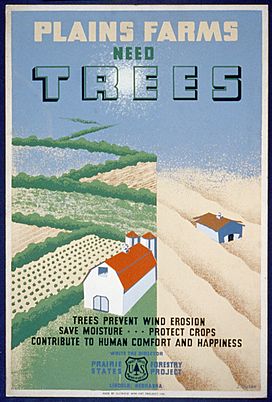Great Plains Shelterbelt facts for kids
Quick facts for kids Great Plains Shelterbelt |
|
|---|---|

Plains States Forestry Project poster created by the Works Progress Administration (1940)
|
|
| Geography | |
| Location | Great Plains, United States |
| Area | 18,600 square miles |
| Administration | |
| Established | 1934 |
The Great Plains Shelterbelt was a huge project in the United States. It started in 1934 to plant millions of trees across the Great Plains. These trees were meant to act as windbreaks, which are like natural walls that slow down strong winds.
This idea came from President Franklin D. Roosevelt. He wanted to help stop the terrible dust storms of the Dust Bowl era. These storms caused a lot of soil to blow away and made droughts even worse. The United States Forest Service believed that planting trees around farms would slow the wind. This would also help keep moisture in the soil.
By 1942, an amazing 220 million trees had been planted! They stretched for about 18,600 miles (29,900 km). This massive green belt was 100 miles (160 km) wide. It went all the way from Canada down to the Brazos River in Texas. This project was one of the biggest efforts by the U.S. government to solve an environmental problem.
Contents
Why Trees Were Needed: The Dust Bowl
In the 1930s, the Great Plains faced a huge environmental disaster. Years of drought combined with poor farming practices led to the "Dust Bowl." Strong winds picked up dry soil, creating massive dust storms. These storms were so big they could block out the sun. They caused huge damage to farms and made life very hard for people.
The dust storms blew away valuable topsoil. This made it impossible for crops to grow. Farmers lost their livelihoods, and many families had to leave their homes. The government realized they needed a big plan to protect the land.
How the Shelterbelt Project Started
The idea for the Great Plains Shelterbelt came from experts who studied forests. They thought that rows of trees could protect the land from wind. These tree rows would slow down the wind. This would stop the soil from blowing away. It would also help the ground hold onto its moisture.
President Roosevelt officially started the project in 1934. The very first tree was planted on March 18, 1935. It was an Austrian pine planted on a farm near Willow, Oklahoma. This marked the beginning of a huge effort.
The project planned to plant trees across a 100-mile wide zone. This zone stretched from Canada to northern Texas. Farmers were paid to plant and care for these trees. Native trees like red cedar and green ash were often used.
At first, there were some disagreements about how to pay for such a big project. It was going to cost about $75 million over 12 years. President Roosevelt moved the program to the Works Progress Administration (WPA). The WPA was a government program that created jobs during the Great Depression.
The main office for the project was in Lincoln, Nebraska. The United States Forest Service and the Civilian Conservation Corps (another government program that employed young men) helped with the work. This project was also known as the Prairie States Forestry Project.
Planting Millions of Trees
The project was a massive success in its early years. By 1942, workers had planted 30,233 shelterbelts. A shelterbelt is a long row or belt of trees. These shelterbelts contained an incredible 220 million trees. They stretched for 18,600 square miles (48,000 km²).
These tree lines helped protect farms. They reduced wind speed, which meant less soil erosion. They also helped keep moisture in the ground. This made it easier for crops to grow, even during dry periods. The shelterbelts also provided homes for wildlife.
Keeping the Shelterbelts Strong Today
Many of the original shelterbelts are now quite old. Some are not as effective as they once were. This is because the trees are old, or they are too close together. Sometimes, unwanted trees have grown in.
Experts are working to restore these important tree lines. For example, in Nebraska, the Nebraska Forest Service is working with landowners. They are trying new ways to improve the health of the trees. They also encourage new trees to grow. This helps the shelterbelts continue to protect farmland.
In 2010, the government started offering grants to help maintain and restore shelterbelts. This funding helps farmers in states like Kansas, North Dakota, South Dakota, and Nebraska. It's part of an ongoing effort to keep these valuable tree barriers strong for the future.

